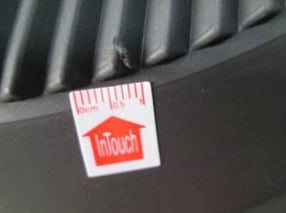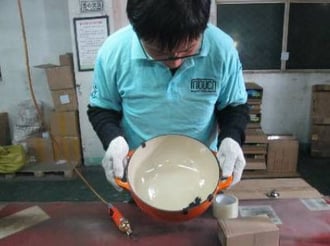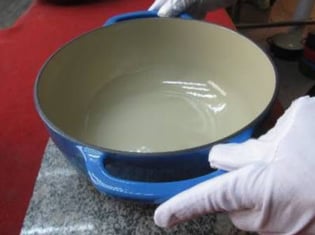Who better to ask than an expert? So I went right to the source and sat down with Megan Young, Client Manager at InTouch and an expert in quality assurance for cookware. During my podcast interview with Megan, she revealed to our listeners and me the basics of cookware inspection, drawing on her own experiences overseeing inspections in Chinese factories and speaking in practical terms that could be understood by both manufacturers and laymen alike.
So, without further ado, let's see how Megan answered some of the industry's most compelling questions to give us a foundation for the basics of cookware inspection.
What kinds of cookware products have you dealt with before?
I've worked with traditional cookware like pots, pans, knives, but I also do a bunch of work with kitchen accessories and, more and more, small electrical appliances that are used in the kitchen.
What are some general signs of low quality that you've seen with cookware products during inspections?
The biggest and most common sign is usually having the items fail industry-standard testing. So for pans that includes the egg test for pans with a non-stick coating, the boil test to make sure water is not leaking out of it and, for electrical appliances, the most obvious  would be the thermal fuse check to make sure that the item actually turns off when it hits a certain temperature instead of overheating.
would be the thermal fuse check to make sure that the item actually turns off when it hits a certain temperature instead of overheating.
Could you tell us a little bit more about the egg testing and the boil testing?
The egg test is basically where you take an egg and fry it on a non-stick surface. If the egg comes off cleanly when you flip it then it passes. If the egg sticks or leaves any residue then that's a fail. For the boil test you just fill the pan all the way up to the rim with water and boil it. Usually, if the pan is poorly constructed, water will start flowing out around the rivets on the handle.
It sort of seeps through the rivets?
It's not like through the rivets just usually there are gaps in the rivets if it's poorly assembled. The hole for the rivet is bigger than the rivet itself.
What are some other on-site tests that you'd typically perform during cookware inspection?
That all depends, for the most part, on the type item you're inspecting. So for all pots and pans you should have a concavity check, which is taking the pan, putting it on a table and seeing if it spins because if you are cooking and you get a pan that spins a nd falls off your table it's really dangerous. If you have a pan that has been impact bonded you want to do a dry boil test to make sure that you don't have molten aluminum oozing out the bottom when you use it. For anything with a glass lid or a glass door - anything glass - you want to make sure there's some type of impact testing and fragment checks.
nd falls off your table it's really dangerous. If you have a pan that has been impact bonded you want to do a dry boil test to make sure that you don't have molten aluminum oozing out the bottom when you use it. For anything with a glass lid or a glass door - anything glass - you want to make sure there's some type of impact testing and fragment checks.
For the impact test and the fragment check, is that a test that you would do for safety or what would be the purpose of doing that kind of testing?
It's definitely for safety. The impact test checks the actual strength of the glass and also it verifies whether or not the glass has been tempered - most cookware needs to be tempered.
So what are some common causes for poor quality in cookware products that you've found in your experience?
Causes for poor quality are pretty much the same for cookware and other items, the first being poor or sloppy assembly where the factory puts it together poorly. The second being substandard materials - often times the factories will change out materials without telling the client. Then there's poor packaging and handling within the factory which, even if the factory has made the product well, can still introduce a lot of defects to the product post-production.
When you're checking the packaging what kinds of things could the factory do that could potentially harm the item?
Well, they could choose substandard cardboard. So you can specify the ply of the cardboard to make it thicker and more protective. Depending on the type of item you have, you need to package it differently. So if you have a large glass bowl you need to put something inside of it it to make sure it doesn't shatter if force is applied when it's in the packaging. A lot of times we see packaging that's just too small for the item, so if the box gets jostled around you'll end up with dents and deformed pans.
What are some of the potential consequences of poor quality with cookware products?
Poor quality in cooking products can lead to a lot of safety risks. So if an item fails on-site testing it indicates there's an increased risk of the item failing or causing physical injury to the consumer. If the item falls apart while in use and you have  hot liquid or hot food inside this container it can get all over you and you can get burns, you can get cuts from broken glass, all sorts of things. And even more than that, most common visual defects like dents, scratches, pitting - these all compromise the integrity of food contact surfaces, and for cookware, if you have a poor food contact surface, that can make the item unhygienic.
hot liquid or hot food inside this container it can get all over you and you can get burns, you can get cuts from broken glass, all sorts of things. And even more than that, most common visual defects like dents, scratches, pitting - these all compromise the integrity of food contact surfaces, and for cookware, if you have a poor food contact surface, that can make the item unhygienic.
So that makes it dirty or maybe potentially not safe to cook with?
Yeah. If you have a bowl that has pitting inside you wash the bowl after use, but if there's pitting there are little bits of food that you can't get out easily while washing, and that can just kind of sit there and grow and mold and anything like that.
Click here to learn about how InTouch can help you with your cookware inspections!
Megan Young is from Dallas, Texas. She studied in the Beijing Institute of Education's CET intensive language program before moving to Shenzhen, China and starting with InTouch. She has been a Client Manager with InTouch since late 2013.







